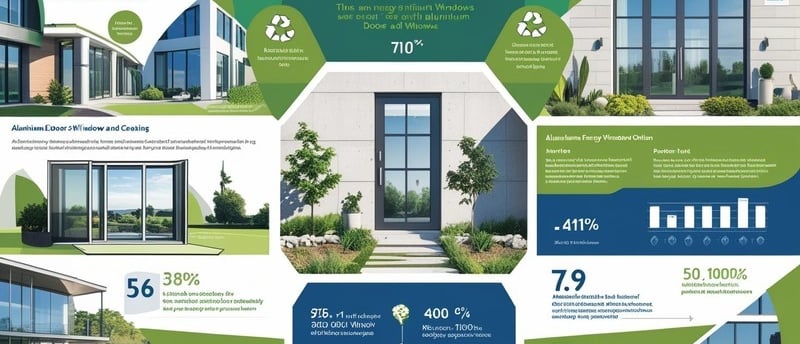The Environmental Benefits of Aluminum Doors and Windows: Why They are the Future of Sustainable Construction
6/5/20255 min read


Understanding Sustainable Aluminum as a Green Building Material
Aluminum has emerged as a cornerstone of sustainable building practices, owing to its unique properties and myriad benefits. As a material, aluminum is renowned for its lightweight yet robust characteristics, making it an ideal choice for doors and windows in construction. Its high strength-to-weight ratio not only allows for design flexibility but also reduces transportation energy costs, thereby minimizing the overall carbon footprint associated with construction projects.
One of the most significant attributes of aluminum is its recyclability. Unlike many conventional materials, aluminum can be recycled indefinitely without losing its structural integrity. This cycle of recycling significantly curtails waste and decreases the necessity for raw material extraction, which is resource-intensive and environmentally damaging. With approximately 75% of aluminum produced to date still in use, the recycling of aluminum plays a vital role in promoting a circular economy within the building sector.
The increasing demand for green building materials has further solidified aluminum's position in sustainable construction. Many industries have begun to recognize and adopt certification standards such as LEED (Leadership in Energy and Environmental Design) that promote eco-friendly construction practices. Aluminum products often qualify for these certifications due to their recyclability and energy efficiency. These standards encourage builders and developers to select materials that not only meet aesthetic and functional requirements but also adhere to sustainable principles.
In addition, the attention to environmental impact and the push towards sustainable practices have created a burgeoning market for aluminum as a building material. As consumers become increasingly environmentally conscious, the construction industry is responding by integrating aluminum into their designs and frameworks. This shift demonstrates a collective movement toward sustainable development, with aluminum serving as a frontrunner in promoting more environmentally responsible construction methodologies.
Energy Efficiency of Aluminum Windows and Thermal Break Doors
Aluminum windows and thermal break doors play a vital role in enhancing energy efficiency within buildings. Their innovative designs incorporate advanced insulation technologies that significantly reduce energy consumption. One of the primary methods these products utilize is the thermal break, a crucial element that separates the interior and exterior sections of aluminum frames. This separation effectively minimizes heat transfer, keeping buildings warmer in winter and cooler during the summer months. As a result, thermal break doors and aluminum windows can help maintain a consistent indoor climate, which reduces the reliance on heating and cooling systems.
Studies have indicated that buildings equipped with thermal break aluminum doors can experience energy savings of up to 30% compared to those with standard materials. The insulation properties of thermal breaks create an economic advantage by lowering heating and cooling costs, ultimately leading to substantial financial savings over time. For instance, according to a report by the Department of Energy, replacing traditional windows with energy-efficient alternatives, such as aluminum options with thermal breaks, can save an average household more than $400 annually on energy bills.
In comparison to other materials like wood and vinyl, aluminum windows and doors stand out in terms of durability and energy efficiency. While wood can warp and vinyl can become less efficient over time, aluminum maintains its shape and structural integrity despite exposure to weather elements. This durability, combined with its energy-efficient features, positions aluminum products as a future-forward choice in sustainable construction. The reduced energy consumption contributes positively to the overall environmental footprint of buildings, reinforcing aluminum’s status as a material aligned with sustainability goals.
Durability and Low Maintenance: Advantages of Aluminum Doors and Windows
Aluminum doors and windows are renowned for their exceptional durability, making them an increasingly popular choice in sustainable construction. One of the primary attributes of aluminum is its remarkable resistance to harsh weather conditions, which ensures longevity and reliability over time. Unlike wood, which can warp, crack, or rot due to moisture, or vinyl, which may become brittle in extreme temperatures, aluminum maintains its structural integrity, thus significantly reducing the likelihood of needed repairs or replacements. This resilience not only enhances the performance of buildings but also contributes positively to their overall lifespan.
Furthermore, aluminum is inherently corrosion-resistant due to a natural oxidation process that forms a protective layer on its surface. This characteristic makes aluminum doors and windows an ideal option for coastal or humid environments where exposure to salty air and moisture can degrade other materials. As a result, these fixtures require minimal maintenance compared to their wooden or vinyl counterparts, which may necessitate regular treatments, painting, or sealant applications to ensure protection against the elements.
The longevity of aluminum doors and windows aligns closely with sustainable practices in construction. By choosing these durable materials, property owners and builders minimize waste generation associated with frequent replacements and repairs. With a longer lifespan, fewer resources are consumed over time, thereby contributing to a reduced environmental footprint. Additionally, modern manufacturing processes of aluminum products often involve recycled materials, enhancing their eco-friendliness and further supporting sustainable development goals.
In essence, the durability and low maintenance requirements of aluminum doors and windows present clear advantages that benefit both homeowners and the environment. Such features not only offer peace of mind regarding functionality and aesthetics but also underline a commitment to sustainability by lowering construction waste and extending the lifespan of building materials.
The Future of Sustainable Construction: Trends and Innovations in Aluminum Applications
As the construction industry pivots towards sustainability, aluminum has emerged as a prominent choice for manufacturers and architects alike, particularly in the creation of doors and windows. The material's lightweight yet durable characteristics provide significant advantages, allowing for more efficient transportation and installation processes, thus reducing overall carbon footprints. A key trend is the increasing adoption of aluminum in high-performance building projects, where energy efficiency and environmental impact are paramount.
Innovations in aluminum technology continue to evolve, enhancing its feasibility as a sustainable building material. For example, advanced coatings and finishes have improved aluminum's thermal efficiency, leading to reduced energy costs in both residential and commercial structures. These innovations not only improve longevity but also minimize the maintenance efforts required, significantly contributing to the lifecycle sustainability of buildings. Another prominent trend is the integration of recycled aluminum in building projects, which reinforces the circular economy by reducing the demand for new resources and conserving energy during manufacturing.
Several landmark buildings serve as illustrations of aluminum’s transformative role in sustainable construction. For instance, the Edge in Amsterdam, often termed the greenest building in the world, incorporates extensive aluminum window systems that facilitate natural light and passive heating, thereby reducing energy consumption. Additionally, the use of aluminum framing in the innovative Bosco Verticale in Milan showcases how the material supports vertical forest concepts in urban settings, integrating nature and architecture to promote ecological balance.
The architectural community continues to recognize aluminum's value, driving a paradigm shift in building design toward sustainability. By leveraging advanced technologies and emphasizing eco-friendly practices, builders are not only meeting regulatory standards but are also offering aesthetic appeal and functionality. This positions aluminum doors and windows as essential components in the ongoing evolution of sustainable construction, emphasizing their future relevance in green architecture.
